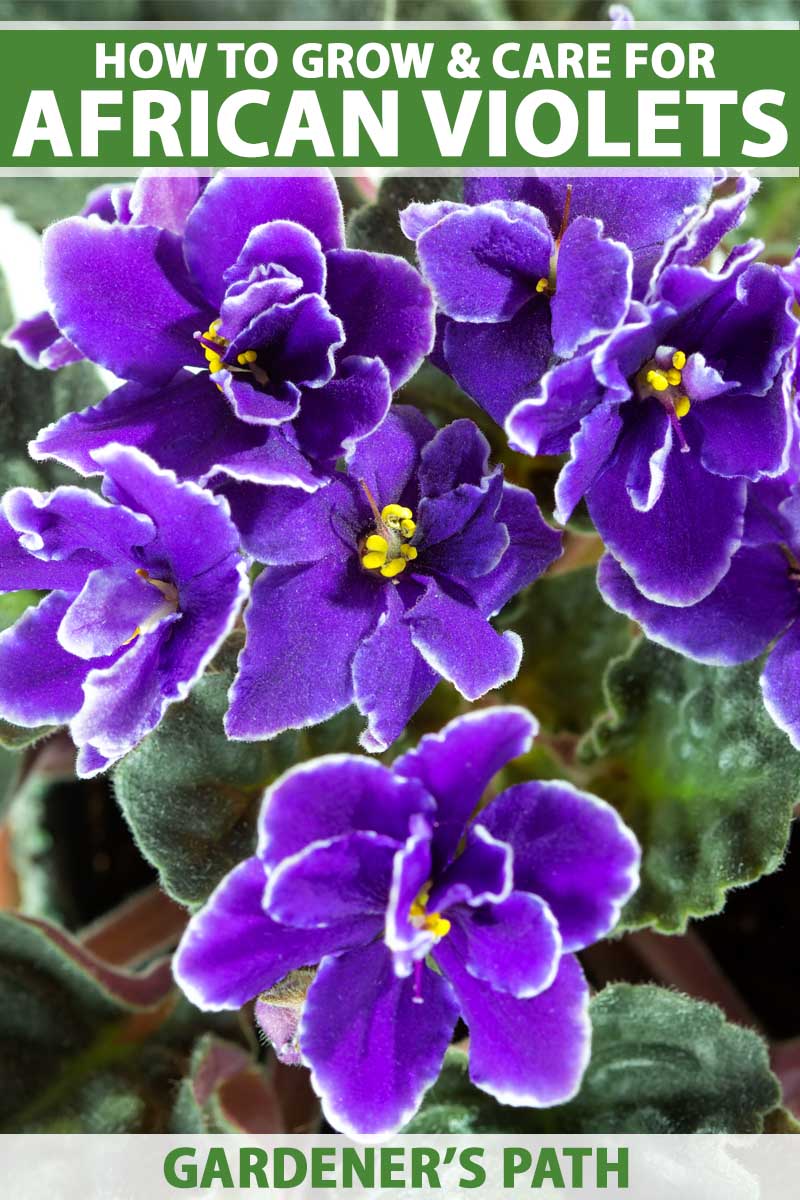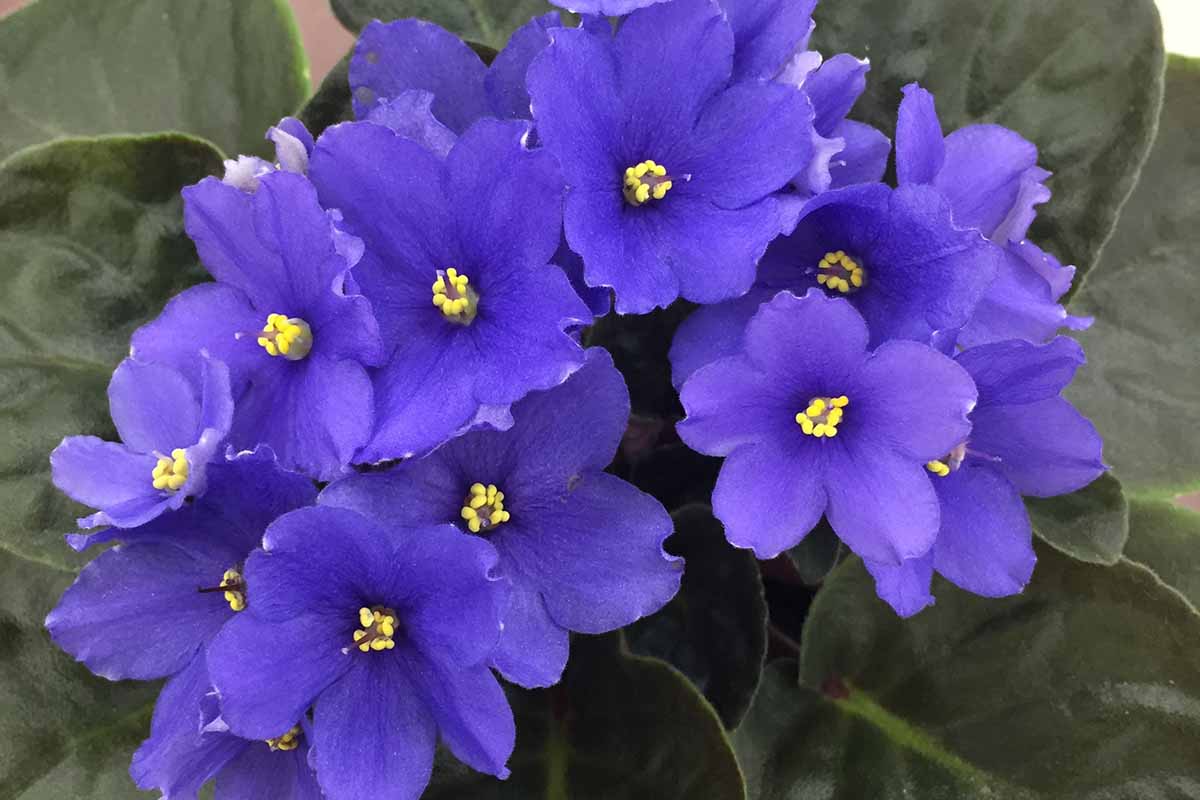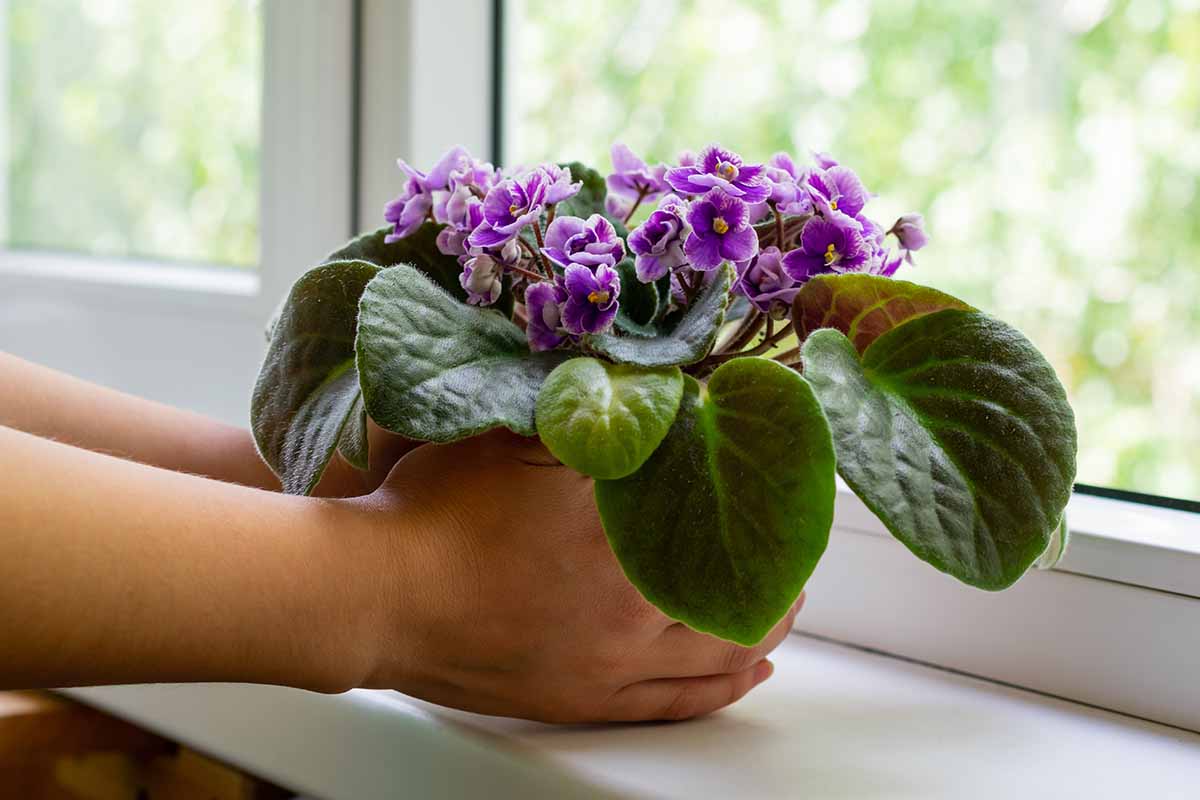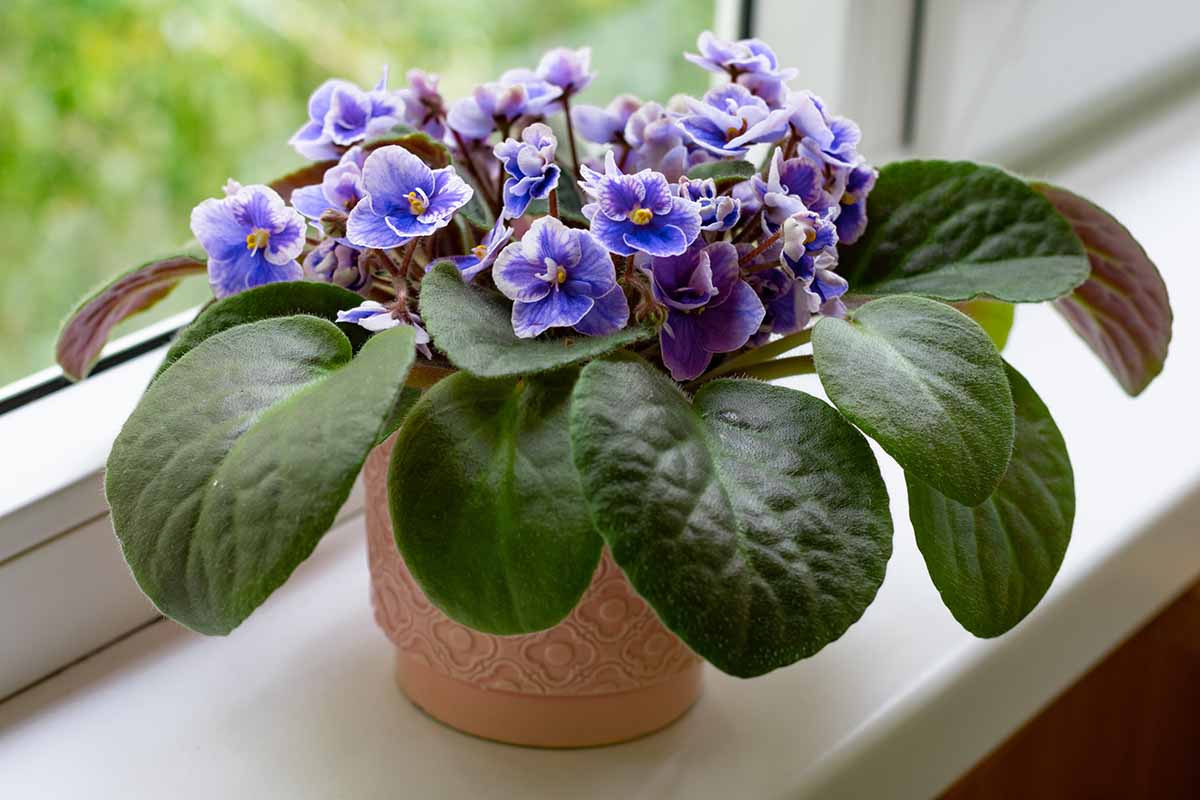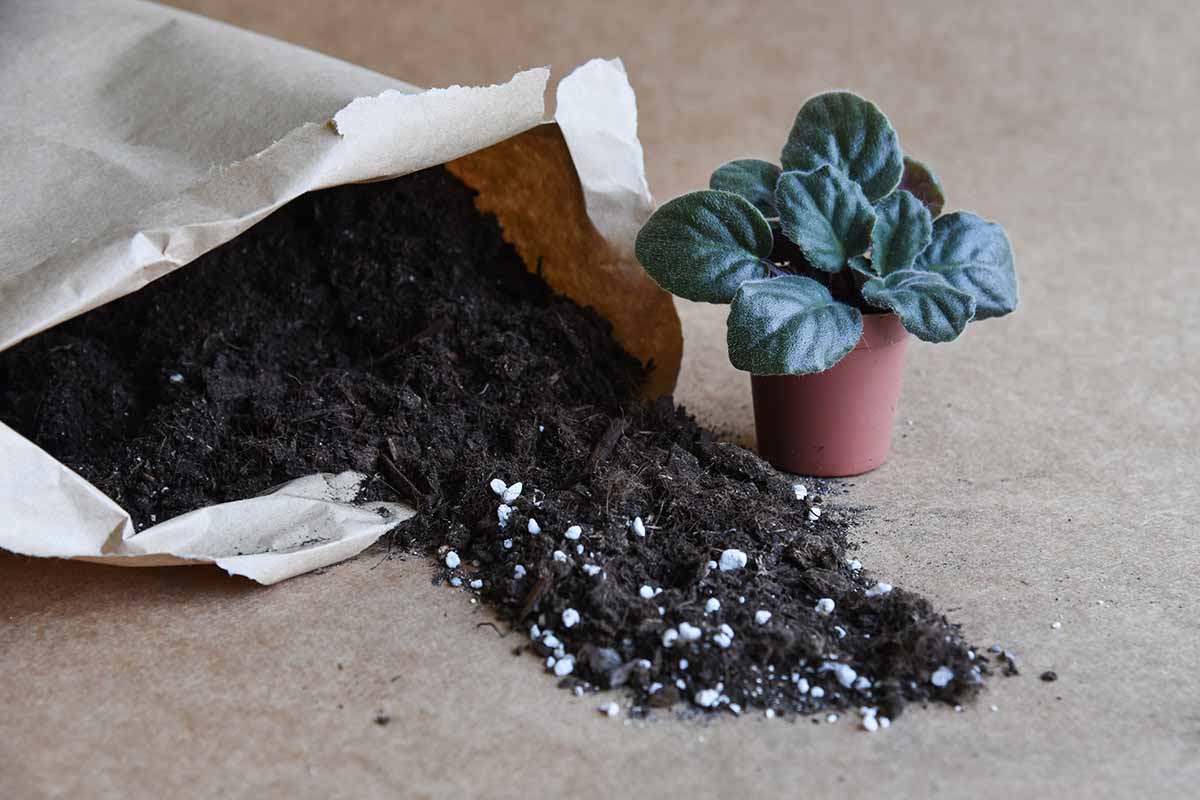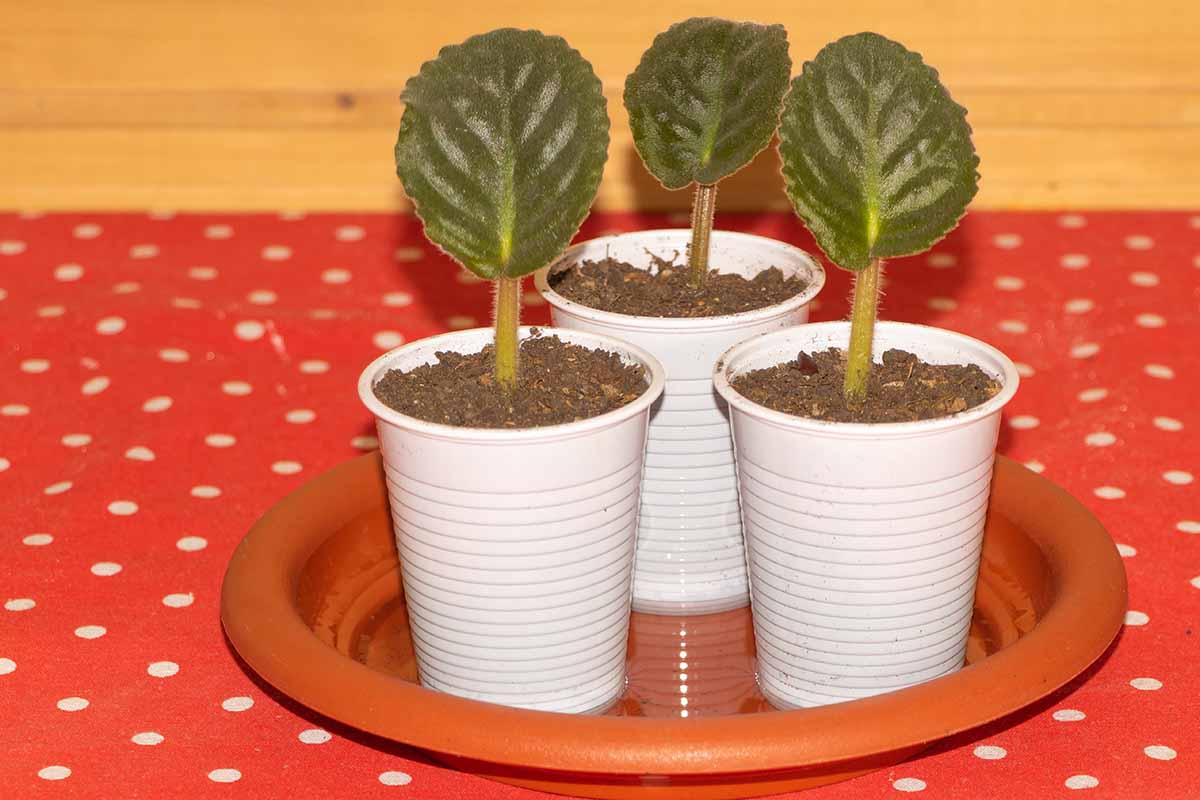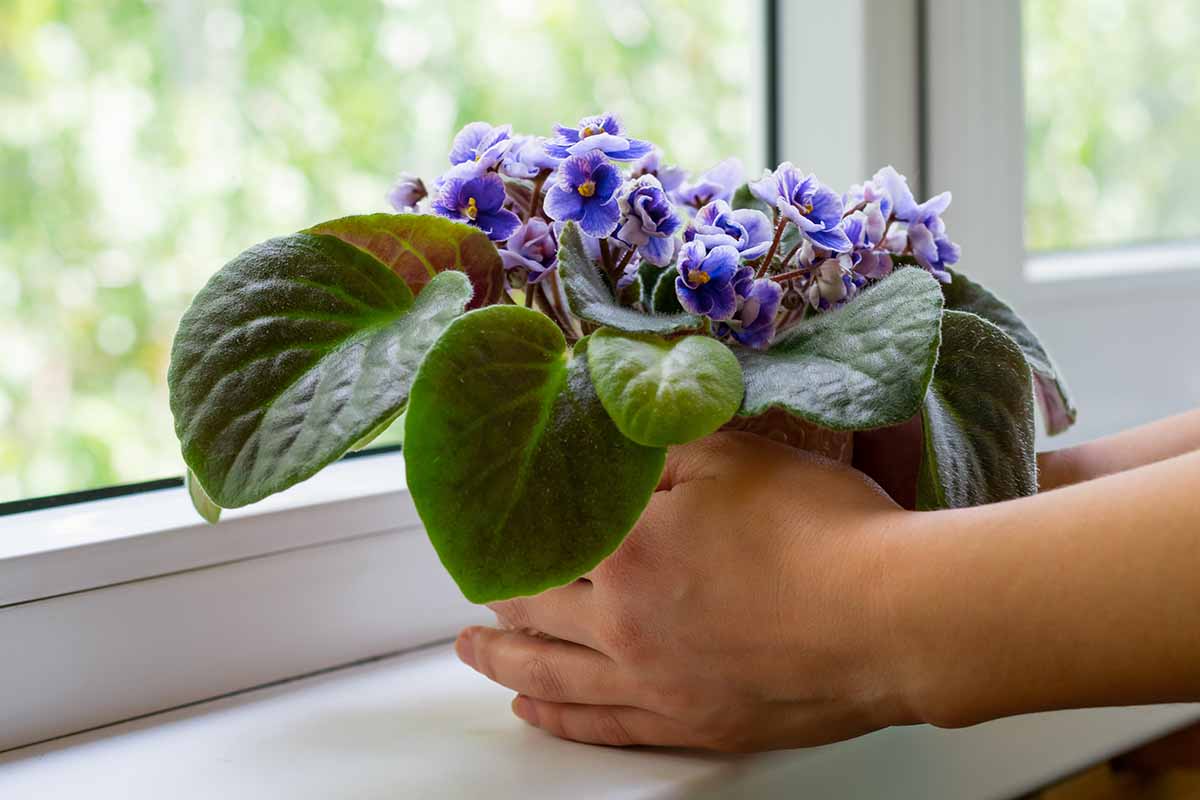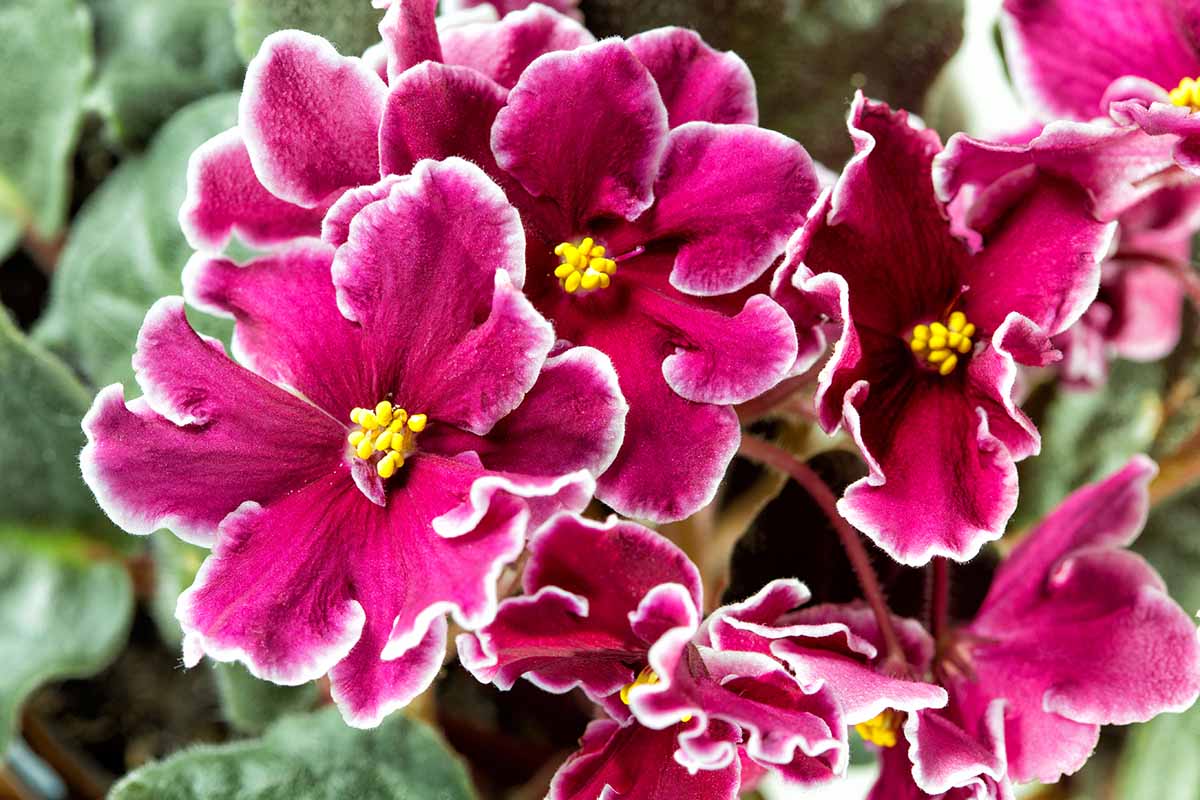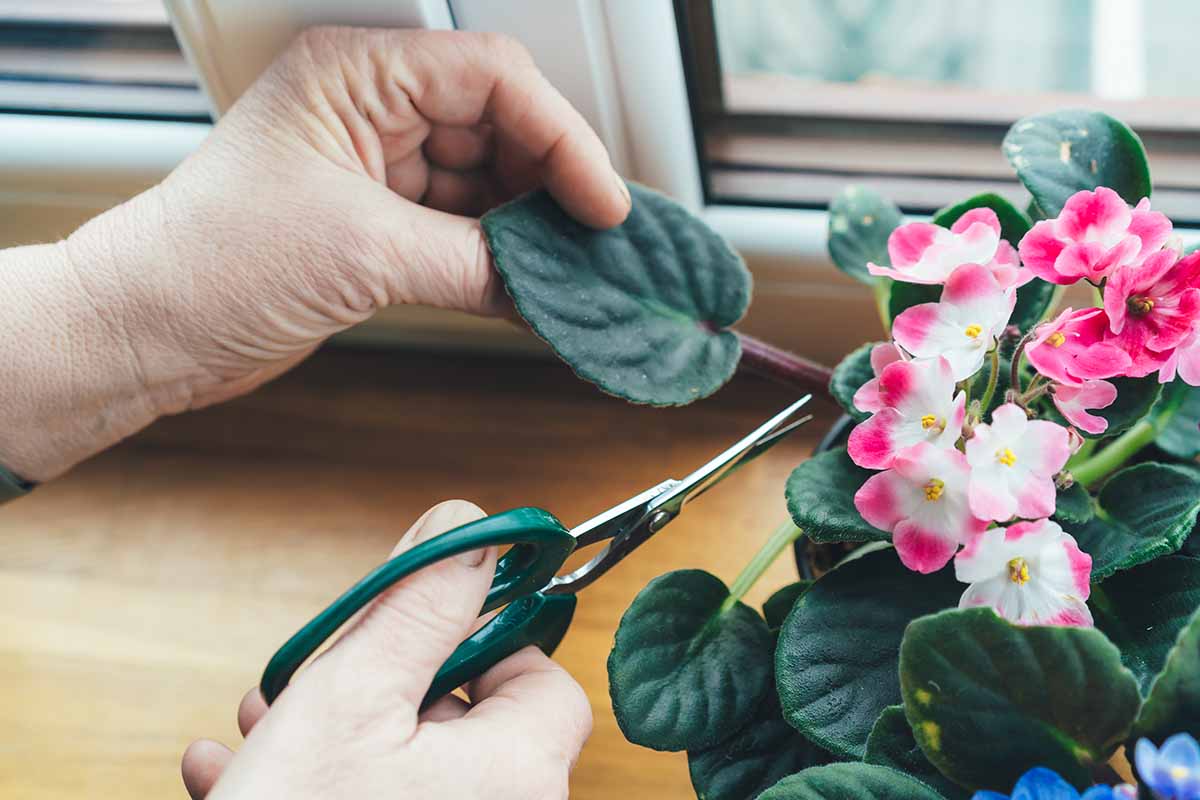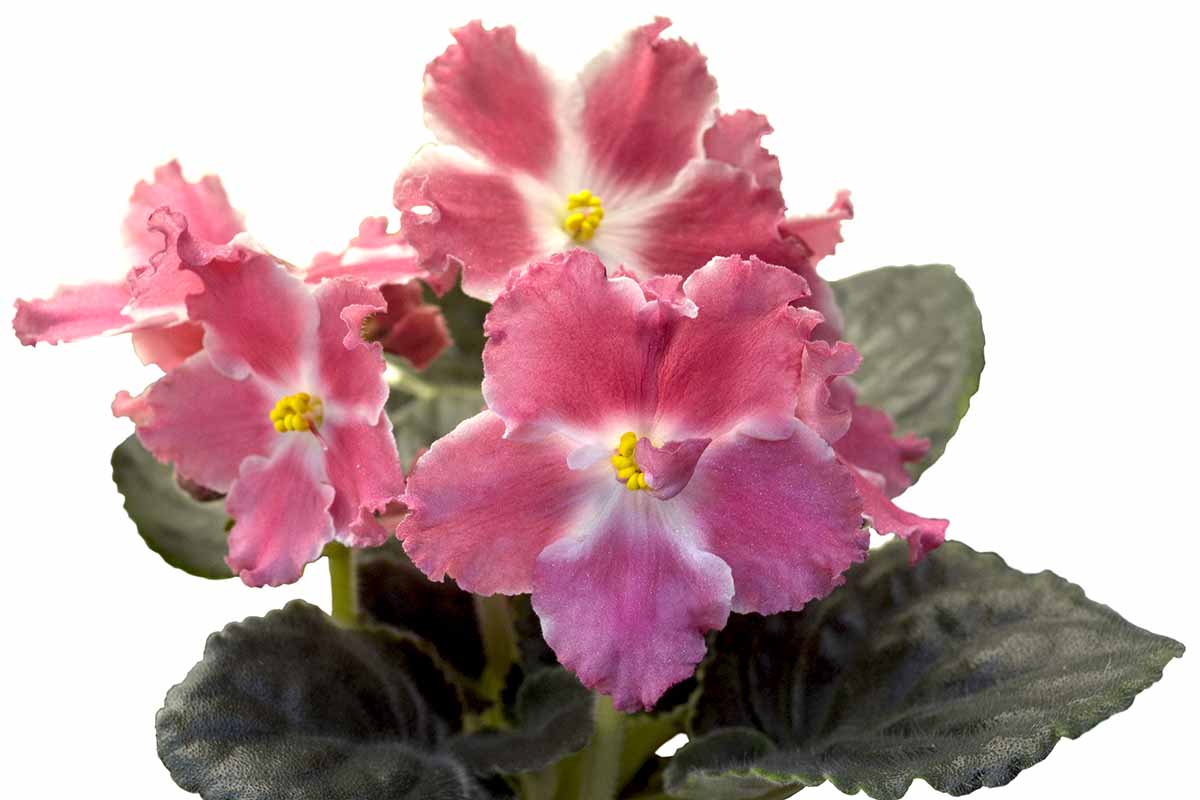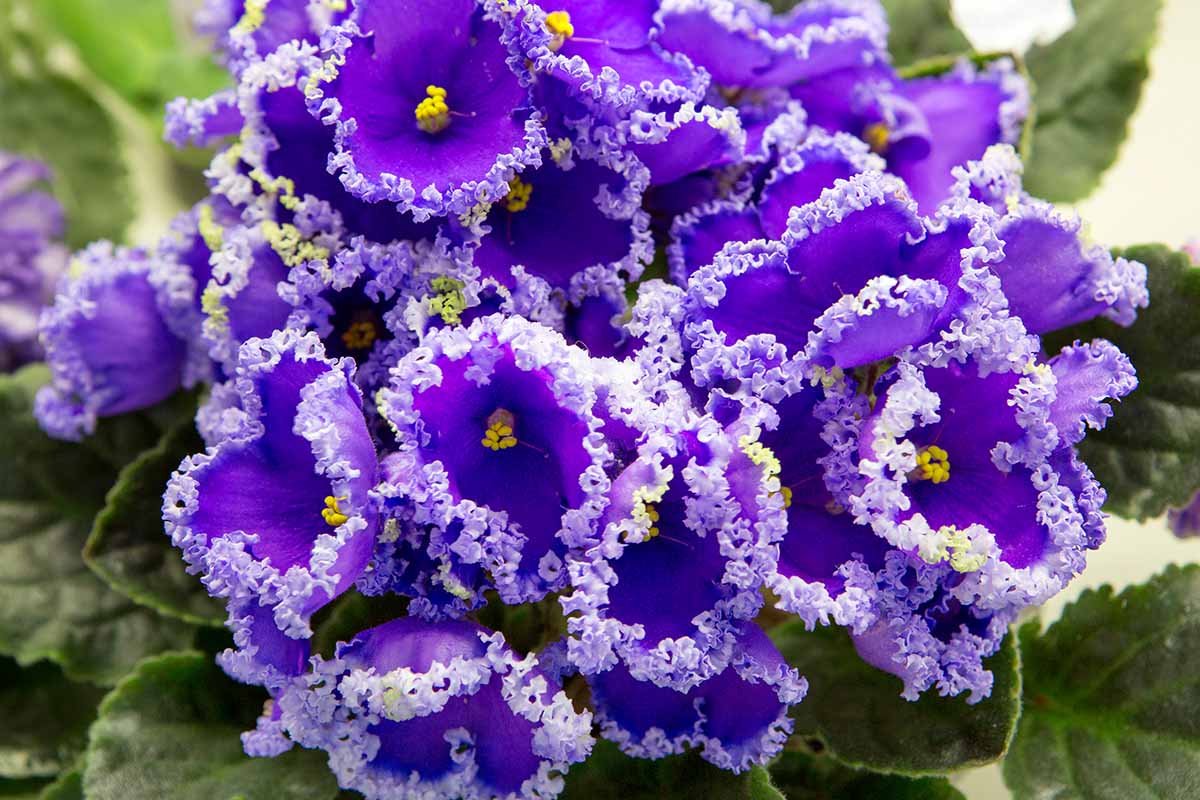She was head of the African Violet Society chapter in the city where I grew up and she assured young me, as she lovingly watered and cared for her elegant and clearly happy plants, that raising African violets was a piece of cake. We link to vendors to help you find relevant products. If you buy from one of our links, we may earn a commission. I could barely keep the leaves from turning soggy and falling off, let alone coaxing the plants to bloom! But by my teens, I had figured out how to make them not only thrive but how to propagate them as well, even creating new plants with unique characteristics. You could say I caught the Saintpaulia bug. Edith would be proud. I’m delighted to see that these plants, which fell out of favor and were replaced in popularity by things like succulents and fiddle-leaf figs, are finding their way back into the limelight. Once you know how to grow them, they really are pretty simple to care for. And they’re one of the few houseplants that will consistently give you a floral display throughout the year. We’re going to help you make your African violets the talk of the town, and here’s what we’ll go over to that end: We’re going to need to define a few terms before we dive in. As with any extensively cultivated plant, there are a lot of descriptions and terms that are used to explain what we’re dealing with.
What Are African Violets?
Known as gesneriads, or plants from the botanical family Gesneriaceae, African violets were recently reclassified by taxonomists. Previously considered members of the Saintpaulia genus – and often still described this way – they are now classified as part of the Streptocarpus genus (often abbreviated as Str.) within the Saintpaulia section of the Streptocarpella subgenus. There are 10 species in this section, including Str. afroviola, Str. brevipilosus, Str. goetzeanus, Str. inconspicuus, Str. ionanthus, Str. nitidus, Str. shumensis, Str. teitensis, Str. ulugurensis, and Str. watkinsii. You’ll see two growth habit types among African violets. The first is trailing, which features cascading growth and multiple stems. Blossoms emerge from each stem, and plants are bushy with a weeping form, with flowers covering the foliage. The other type is the rosette form. It has one main stem, and the blossoms emerge from that central point. Years ago, the only option you’d typically find had single, purple, five-petaled flowers and your basic green leaves. These days, there is a much wider range in terms of variety. No longer just violet, you can also find pink, white, yellow, mauve, blue, and lavender blooms today, as well as combinations of these colors, and leaves in a range of hues. You can find the original singles as well as semi-double flowers with more than five but less than 10 petals, or double flowers with more than 10 petals. Some varieties are even described as “double-plus,” with over 20 petals! When it comes to shape, there are bell-shaped flowers that have fused petals curved inward in a narrow cuplike form. Star-shaped flowers have five fused petals, and cups form a more shallow cup then bells. You can also find frilled flowers, which as you might guess, have ruffled, frilly-edged petals. In addition to single, solid colors, you will also see bicolor and multicolored blossoms. And then there are the patterns, which appear as the result of particular genetic mutations in hybrid cultivars. Chimera types are hybrids that have pinwheel stripes. Genevas have white borders and a colored center. Those with dark eyes are primarily white with a dab of color at the center, while white-eyed blooms display the opposite coloration. Varieties also exist with colored or speckled edges. Thumbprint-patterned blooms look like someone pressed their thumb into the center of the petals to create marks in a contrasting color. Fantasy types have multicolored petals with contrasting streaks or rays. You can also find “puffs,” which have splotches of color, as well as streaked and dotted blooms, which appear just as they sound. Watermarked African violets have colored petals with a dark band surrounding them and separating it from a second color at the center. And there are feathered ones with darker-colored veins throughout lighter petals. The fun doesn’t stop there! There are fluted flowers too, which have five petals with twisted tips. And wasp flowers have five petals, but two of them are more narrow than the others. These plants come in several different sizes as well. They can be standards, or any size above eight inches, semi-miniatures, meaning they are under eight inches in diameter, and miniatures, with a spread less than six inches. We haven’t even covered leaves yet! Besides the standard, these may be pointed, round, oval, heart-shaped… There are “girl” leaves, which have scalloped edges with a single white dot at the base. There are also “boy” leaves, which are the standard, classic leaves of yore. In addition, the leaves can be “quilted,” which is when the leaves are somewhat puffy with depressed veins. Spooned leaves are slightly cupped, and some are ruffled, with frilly edges. Bustled or bustle-backed leaves are single leaves with a smaller pair at the base. You might also see wavy foliage, which has gentle waves at the margins. There are always new characteristics popping up, and new hybrids can be named and registered with the African Violet Society of America, so there are always exciting new options coming to the market.
Cultivation and History
The former Saintpaulia genus was named after, unsurprisingly, a man named Baron von Saint Paul. He was a German governor of Tanzania who first described the plant, specifically the ionanthus subspecies, in 1892 and brought it to Europe. Originally, it was found throughout eastern Africa. You can still find this plant growing wild in the mountains of Tanzania and Kenya, though it’s threatened by habitat loss. Today, the African violet has become an exceptionally popular houseplant across the globe, with interest among gardeners waxing and waning somewhat from one generation to the next.
Propagation
Success with African violets starts with the roots. These plants have fine roots, and they can rot extremely easily. For all of the following propagation methods, keep one thing in mind: only use well-draining soil. It doesn’t matter what method you choose: the key to success is a substrate that drains readily. To help avoid rot, I recommend making your own potting mix so you can ensure that it is extremely well-draining. Pick up a package of standard potting soil and mix it with equal parts perlite, pumice, or rice hulls. Fill a seed tray with a seed-starting mix or the DIY mix described above. Don’t use potting soil – it’s too heavy. Their preferred pH range is slightly acidic, with a pH of about 6.5 to 6.8. African Violet Potting Soil This product is available from Perfect Plants Nursery in two-quart and eight-quart packages.
From Seed
Most African violet cultivars won’t grow true from seed since they are hybrids. Chimeras, for instance, can only be propagated via suckers – only clones will maintain the same genetic traits that give the flowers their unique pattern. For those who wish to propagate new plants by sowing seed, the process takes a while but it’s fairly straightforward. This can also be a fun way to develop new cultivars through cross-pollination. Dampen the mix using a spray bottle so you don’t make any depressions in the medium. Sprinkle the seeds over the mixture but don’t cover them. Don’t worry about spacing. Since the seeds are tiny and hard to handle, we’ll just thin the seedlings later. Place the tray in bright, indirect sunlight. Keep the soil moist with that spray bottle. You have to be diligent about this. If the soil dries out the seeds will dry out too. And if that happens, they won’t germinate. Once you start to see little seedlings emerge, thin them out by snipping the weaker ones so they’re spaced at least three inches apart. Now you can switch to gently watering with a watering can, preferably one without a shower-type head so as not to disturb the seedlings – water that comes down on plants like a gentle rain can be good for delicate seedlings, but you generally want to water directly at the soil line rather than sprinkling foliage. Keep the soil moist but not wet. Once the plants have developed three or four leaves each, you can transplant them into individual containers.
From Leaf Cuttings
Leaf cuttings can be taken at any time of year, but spring tends to be best, when they are actively growing. To propagate leaf cuttings, the soil should be even more well-draining than what you’d normally use. While potting mix combined with equal parts perlite or another substrate will work, I recommend something closer to one part potting soil and two parts perlite, or ideally, the DIY mix suggested above. Fill a two- or three-inch pot with your mix and use a pencil to make a small hole in the center. Cut a healthy leaf from a mature plant, taking care to remove as much of the petiole or stem as possible. Dip the end in rooting hormone and place it in the potting medium in that hole you made previously, with the stem pushed into the soil no more than an inch deep. You might need to prop the leaf up with a chopstick or toothpick. Water the medium well so it feels moist but not soggy. Place a glass cloche or tent a plastic bag over the container to create a little greenhouse. Place the pot in bright, indirect light. When you see new foliage, your rooted cutting is ready to transplant. Read our guide for a more comprehensive look at propagating African violets this way.
From Suckers
Also known as pups, suckers are miniature plants that sprout from the base of the parent, often in response to environmental stressors. You can cut these off and start new plants. To do this, water the parent plant well and then wait a few hours. In the meantime, fill a two- or three-inch pot with the same potting mixture described in the beginning of this section. Poke a small indentation in the center with a pencil or chopstick. Find the base of the pup and cut it away from the parent plant using a clean pair of scissors. Dip the cut end in rooting hormone and place it in the shallow divot you made. Water the medium well so it feels moist but not wet and place a cloche or clear plastic bag over the pot to simulate the conditions you might find in a teeny-tiny greenhouse. Set the pot in a location where it will receive six hours of bright, indirect light per day. Keep the soil moist and remove the bag once a day for a few hours. Eventually, though it can take up to a month, you’ll start to see new growth. That means success! You can pot up your new plant now. For the details on that process, keep reading.
Transplanting
When you propagate, purchase, or obtain a new African violet some other way, your first move should be to put it in a container. But if the soil is adequate and the container it came in is already sized appropriately, immediate transplanting may not be necessary. African violets need to be grown in small pots to be happy. You’ll probably think you’re using something too small at first if you aren’t familiar with growing these plants, but chances are it’s just right. Choose a container that is about a third as wide as the plant, as described in a bit more detail in the section below. To transplant, remove the violet from its container and gently loosen the roots. Place it in the new pot so the roots are covered to the same depth as in the previous container, and fill in with a well-draining mix as described at the beginning of this section.
How to Grow
Place your African violet houseplants about 12 to 24 inches away from a west-, south-, or east-facing window so they will receive bright, indirect light. If that isn’t available, place them 10 to 30 inches away from supplemental grow lights and leave the lights on for six to 12 hours per day. They don’t like to be cold, so choose a location where you can maintain a moderate temperature of 60 to 70°F, away from any drafts. These plants like to feel cozy. They don’t do well if they’re placed in a large pot. A good rule of thumb is to use a pot that is one-third the diameter of the width of the leaves. If your plant measures a foot across, plant it in a four-inch pot. Small pots make watering a bit more difficult, but it’s essential to get this right. The soil needs to stay constantly moist and it should not be allowed to dry out. But the roots shouldn’t be sitting in standing water either. You can use bottom watering or top watering methods, but be sure to empty the saucer placed beneath your violet’s container if any water collects. Wick-watering or self-watering pots are an even better option. Humidity should be around 40 to 60 percent. Anything less and the flower buds might dry up and fall off before the plant can bloom. Anything higher and fungal diseases become more likely. Unless you absolutely have to, avoid touching the leaves. Leaves that are handled often tend to be smaller and less healthy, as a study by Julia C. Brotton and Janet C. Cole, researchers from the Department of Horticulture and Landscape Architecture at Oklahoma State University and published in the journal HortTechnology in 2009 concluded.
Growing Tips
Provide bright, indirect light for at least six hours a day.Use a pot 1/3 the diameter of the leaves.Keep humidity at 40 to 60 percent.Don’t touch the leaves.
Pruning and Maintenance
As the blossoms fade, grab a spent flower and rock it back and forth. It will pop off away from the stem. Deadheading in this way helps to ensure continued blooming. Don’t remove an entire flower cluster at once. Just remove each flower one at a time, as they fade individually. Remove any dead or damaged leaves as you see them as well. African violets need to be fed regularly, with no exceptions. Feeding once a week with an all-purpose liquid fertilizer diluted to one-eighth strength is about right. You could also fertilize every other week with the same type of product diluted to one-quarter strength. Now, let’s address one of the most exciting and challenging parts of growing African violets: getting them to bloom. These plants can be fussy when it comes to putting out flowers. If you’ve been growing yours for a while and you still aren’t seeing blossoms, first consider the light situation. The perfect location would be as described above, near a bright window or under supplemental electric lights. These need to be woken up by repotting. You don’t need to go up a size, just remove the plant, spread out those roots a little, and repot in fresh soil. Next, think about the last time you fertilized, and consider whether the pot is too large. Specialty fertilizers aren’t necessary, but you will find many products available that are recommended specifically for use on African violets to encourage blooming. Miracle-Gro Blooming Houseplant Food If these conditions check out, make sure the ambient humidity and temperature are high enough. If all else fails, your plant might have fallen asleep, for lack of a better term. Some violets decide that they’re doing perfectly well as they are, thank you very much, and they’re content. If you have a chimera hybrid, it’s entirely possible that it might revert to producing solid-colored flowers. Chimeras have two separate sets of DNA and as they age, they might start to send out growth influenced by the genetics from the solid-colored parent. If you see any solid flowers pop up, cut them off. If the plant begins producing nothing but solid flowers, it’s too late and the chimera trait is gone from the plant. Plants should be repotted at least once a year, but preferably twice a year. The point isn’t to upgrade to a larger pot necessarily but to bury the stem(s) slightly deeper than they were before. African violets naturally drop their lower leaves over time. As this happens, they form what is called a “neck.” This is a stem at the base of the plant without any leaves. Each time you repot, remove the plant from its existing pot and brush away the soil from the base of the plant. Put the violet back in the container sitting so the bottom leaves are just above the soil line and refill the container. Every time you repot, you’ll place the plant just a touch deeper than it was before, burying the stem slightly. You don’t need to go up a size unless the leaves have grown so wide that you need to upgrade to a bigger container to retain that 1:3 ratio. The pot you use should be the same size across as the root ball. Any larger and you’ll encourage root rot and other problems. ‘Cherry Princess,’ a chimera type introduced by Paul Sorano of Lyndon Lyon Greenhouses in 2012, has semi-double to double white, pansy-shaped blooms with fuchsia stripes. That’s how African violet enthusiasts refer to plants that have no name, either because they were never named officially or they were separated from their identity at some point along the way. It happens all the time and many of the plants you find in stores are NOIDs. African Violets in Four-Inch Pots For example, Hirt’s Gardens sells NOID plants in a variety of bloom colors and types as surprise grab-bag selections available in four-inch pots from Walmart. You won’t be able to enter these into any shows, but that doesn’t mean they won’t make lovely houseplants. When it comes to named hybrid cultivars, there are so many to choose from! Just to name a few, the following three are extremely popular: ‘Aromat Leta,’ aka ‘Aroma of Summer,’ has wavy coral thumbprint petals with a white eye and yellow centers. This cultivar was produced by hybridizer Natalia Skornyakova in 2015/2016. ‘Rose Quartz’ belongs to the Little Jewel series from the Optimara brand at Holtkamp Greenhouses, and was first introduced in 1988. It has semi-double pink flowers with pink centers. For some more exceptional cultivars, check out this roundup of our favorite African violet cultivars (coming soon!).
Managing Pests and Disease
Healthy African violets are fairly resistant to pests and diseases, despite their finicky reputation. But give them the wrong amount of light, not enough food, or too little or too much water, and you’re inviting problems.
Insects
Since African violets are primarily grown indoors, you’ll most often see the common houseplant pests. Many of these are brought in on newly purchased plants, so give your new babies a good look and even a week or two of quarantine away from other indoor flora before you introduce them to the pack.
Cyclamen Mites
Cyclamen mites (Phytonemus pallidus) are tiny little pests that attack African violets, strawberries, and cyclamens. They thrive in warm, humid environments, so those keeping their violets in cloches or glass cabinets might run into this pest. Any plants grown in conditions above 80 percent humidity and at temperatures over 60°F is at risk. While they’re similar to spider mites, they don’t spin webs and they can’t be seen by the naked eye. Instead of looking for the insects, look for dusty white patches on the leaves, and new leaf and flower growth that looks distorted, curled, or fused. If you discover signs of infection and you aren’t in love with this particular specimen, toss it out. It’s much easier than trying to control an infestation and these pests spread incredibly quickly. At the very least, don’t use an infested plant to make cuttings and be sure to keep it isolated. To treat the problem, apply neem oil, taking care to saturate the tops and bottoms of the leaves. Do this every four days for three weeks. Wait a few months to see if new growth looks healthier. If not, repeat treatment.
Mealybugs
Mealybugs are a common pest of all kinds of houseplants. They’re small critters, about a quarter-inch in length, and have a waxy, cottony coating that covers their bodies. These pests use their sucking mouthparts to feed on plant sap and you usually find them on leaves and stems rather than flowers. Citrus (Planococcus citri) and comstock mealybugs (Pseudococcus comstocki) feed on African violets. When they’re present, the leaves will be distorted and growth is stunted. You might also see yellowing and browning of the leaves. In addition to the pests themselves, look for the sticky honeydew that they leave behind. If you catch an infestation early, you can get rid of it by dipping a cotton swab in rubbing alcohol and wiping it on each of the mealybugs. This removes their protective coating. Do this daily until you don’t see any more mealybugs. For a larger infestation, grab an insecticide that contains pyrethrins. Many of these are not rated for indoor use, so you’ll need to take your plant outside when you spray it and leave it out for a bit. If it’s winter, quickly spray and then place the pot in a garage or other protected space for a few hours. Otherwise, find a treatment product that is rated for indoor use. You can learn more about mealybugs and how to control them in our guide.
Thrips
I’m not a fan of any types of pests, but thrips really drive me nuts when they attack African violets. That’s because the most obvious symptoms involve the blossoms. Here you are, enjoying yourself and caring for your plants, just counting the days until those buds open to reveal big, beautiful blossoms. But then they turn mushy and soft, or they might open and then rapidly dry out, with a papery texture. Or perhaps the buds don’t open at all! If this happens, your plant might have a little family of western flower thrips (Frankliniella occidentalis) making themselves at home. They don’t usually impact the foliage, but they really do a number on the flowers. You probably won’t notice the insects themselves because they’re shy, pale, and only one millimeter long. The solution – and here is another reason that I hate these tiny jerks – is to remove all of the flowers and buds for a period of six months. It sucks, but you effectively starve the thrips to death because you’ve removed their source of food. In the grand scheme of things, what is six months? A mere blink of an eye. Certainly worth eradicating this irritating pest. Oh, and if you are on the fence about pruning off a big, beautiful flower, remember that this pest transmits an incurable virus. Don’t ignore the problem! For more information about thrips, check out our guide.
Disease
The most common diseases of this beautiful plant are easy to avoid with care. But one is difficult to avoid and incurable, though uncommon.
Impatiens Necrotic Spot Virus
This incurable disease is carried by those western flower thrips that we talked about above. As these pests feed, they can spread the virus from plant to plant. The symptoms are pretty hard to sum up because they look like so many other issues. We’re talking about wilting, leaf yellowing, a lack of flowering, ring spots or sunken spots, and stunted growth. The only way to know for sure if your plants have contracted this virus is to send a sample to your local extension office. If you get a positive confirmation, toss your plants.
Powdery Mildew
Powdery mildew is super common and it shows up as white powdery spots on the leaves. The best way to avoid this disease is to keep humidity under 60 percent, ensure that plants have plenty of air circulation, and if your home temperatures fluctuate by more than 15 degrees, try placing your plants somewhere with more constant temperatures. Once the disease is present, check out our guide for dealing with powdery mildew. And don’t feel bad, it happens to everyone at some point.
Root Rot
Root rot starts with limp leaves on the exterior of the plant. It looks a little like the plant is wilting, but this isn’t the time to add more water. Touch the soil first. Does it feel moist? If so, it’s most likely root rot. Remove the plant from its container and brush or knock away as much soil as you can. Place the plant on a towel and let the roots dry out for half an hour or so. Now, spray the roots with copper fungicide and repot. Be careful not to overwater going forward. You might have to treat again in a month, but if you stay diligent, your plant will recover.
Best Uses
There’s hardly a plant that I can think of that is better suited to use indoors as a potted specimen. It’s perfect. While you can put some of the trailing types in a hanging basket if you want, you’ll miss out on most of the display that way. Keep these plants in pots and enjoy. It’s pretty difficult to find a plant that blossoms as long as this one does, especially with the huge range of flower colors and styles. Are you new to African violets? Trying them once again after years of looking toward other plants? Regardless, which cultivars or hybrids do you love? There are so many excellent ones and finding new favorites is always a welcome discovery. Share with us in the comment section below! Are you a houseplant aficionado? Are you looking for other species to fill your home with? If the answer is yes, you might find these guides helpful:
How to Grow and Care for Arrowhead PlantsHow to Grow and Care for Aluminum Plants (Watermelon Pilea)How to Grow and Care for Christmas Cactus
